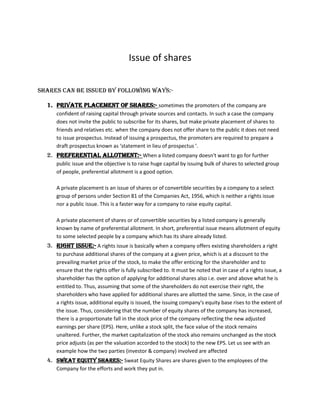
Issue of shares
- 1. Issue of shares shares can be issued by following ways:- 1. Private placement of shares:- sometimes the promoters of the company are confident of raising capital through private sources and contacts. In such a case the company does not invite the public to subscribe for its shares, but make private placement of shares to friends and relatives etc. when the company does not offer share to the public it does not need to issue prospectus. Instead of issuing a prospectus, the promoters are required to prepare a draft prospectus known as ‘statement in lieu of prospectus ’. 2. Preferential allotment:- When a listed company doesn't want to go for further public issue and the objective is to raise huge capital by issuing bulk of shares to selected group of people, preferential allotment is a good option. A private placement is an issue of shares or of convertible securities by a company to a select group of persons under Section 81 of the Companies Act, 1956, which is neither a rights issue nor a public issue. This is a faster way for a company to raise equity capital. A private placement of shares or of convertible securities by a listed company is generally known by name of preferential allotment. In short, preferential issue means allotment of equity to some selected people by a company which has its share already listed. 3. Right issue:- A rights issue is basically when a company offers existing shareholders a right to purchase additional shares of the company at a given price, which is at a discount to the prevailing market price of the stock, to make the offer enticing for the shareholder and to ensure that the rights offer is fully subscribed to. It must be noted that in case of a rights issue, a shareholder has the option of applying for additional shares also i.e. over and above what he is entitled to. Thus, assuming that some of the shareholders do not exercise their right, the shareholders who have applied for additional shares are allotted the same. Since, in the case of a rights issue, additional equity is issued, the issuing company's equity base rises to the extent of the issue. Thus, considering that the number of equity shares of the company has increased, there is a proportionate fall in the stock price of the company reflecting the new adjusted earnings per share (EPS). Here, unlike a stock split, the face value of the stock remains unaltered. Further, the market capitalization of the stock also remains unchanged as the stock price adjusts (as per the valuation accorded to the stock) to the new EPS. Let us see with an example how the two parties (investor & company) involved are affected 4. SWEAT EQUITY SHARES:- Sweat Equity Shares are shares given to the employees of the Company for the efforts and work they put in.
- 2. In India, the concept of SWEAT EQUITY SHARES was started by Infosys. Sweat Equity Shares are given to the employees at a discounted rate of market value. The whole idea behind giving Sweat Equity is to make the employee feel that he/she is a part owner in the company. When employees feel their company has their own funds invested in it, they get better motivated and work more earnestly towards company's progress. 5. Employees stock option plan:- An employee stock option (ESO) is a call option on the common stock of a company, granted by the company to an employee as part of the employee's remuneration package. The objective is to give employees an incentive to behave in ways that will boost the company's stock price. If the company's stock market price rises above the call price, the employee could exercise the option, pay the exercise price and would be issued with ordinary shares in the company. The employee would experience a direct financial benefit of the difference between the market and the exercise prices. If the market price falls below the stock exercise price at the time near expiration, the employee is not obligated to exercise the option, in which case the option will lapse. Restrictions on the option, such as vesting and non-transferring, attempt to align the holder's interest with those of the business shareholders. 6. Employees stock purchase scheme:- A company-run program in which participating employees can purchase company shares at a discounted price. Employees contribute to the plan through payroll deductions, which build up between the offering date and the purchase date. At the purchase date, the company uses the accumulated funds to purchase shares in the company on behalf of the participating employees. The amount of the discount depends on the specific plan but can be as much as 15% lower than the market price 7. Public subscription of shares:- a company collects its share capital by issuing shares. A public limited company can issue shares after the compliance of legal formation i.e. after getting certificate for commencement of business and issuing prospectus with the registrar of the company Following are the steps followed by a public company to raise shares
